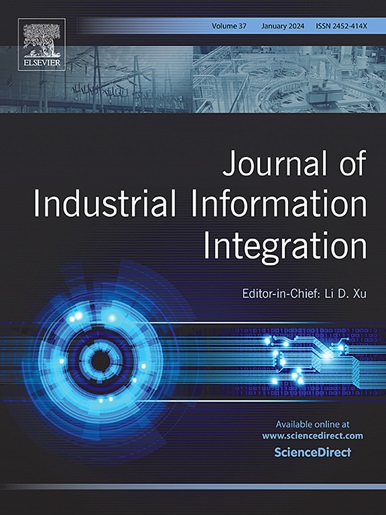面对不可预见的中断,基于毕达哥拉斯模糊粗糙决策的供应链弹性框架开发方法
IF 10.4
1区 计算机科学
Q1 COMPUTER SCIENCE, INTERDISCIPLINARY APPLICATIONS
引用次数: 0
摘要
确保供应链在面对不可预见的中断(如自然灾害、地缘政治冲突或经济衰退)时的弹性(SCRES)是决策者的关键目标。虽然现有文献中提出了许多SCRES框架,但缺乏对这些框架进行排名的研究。此外,这些框架都不能完全满足所有的评估属性。为了解决这一研究缺口,需要注意三个关键的评估问题:多个评估属性的存在,这些属性的不同重要程度,以及数据的变化。因此,多属性决策分析(MADA)方法通过提供合理和逻辑的决策方法,提供了有效的解决方案。这些方法有助于消除特定解决方案提供的信息中的歧义和不确定性。本研究的主要目的是提出一种将毕达哥拉斯模糊粗糙集(PFRS)框架与模糊加权零不一致准则(FWZIC)和模糊意见评分法(FDOSM)相结合的决策方法,以提高其处理复杂和不确定决策场景的有效性。本研究的贡献包括:(1)构建了13个SCRES框架的意见决策矩阵,该矩阵具有两组评价属性,由11个子属性组成,其中7个子属性属于SCRES先行项,4个子属性属于SCRES阶段;(2)采用PFRS重新制定FWZIC,即PFRS - FWZIC法,对评价属性进行优先排序,解决权重过程中的不确定性;(3)使用PFRS重新制定FDOSM,称为PFRS - FDOSM方法,以解决不确定度评估中与数据方差相关的多个障碍标准和关注点;(4)基于形成的意见决策矩阵,结合PFRS-FWZIC和PFRS-FDOSM方法,提出了基于决策的scre框架评价和排序方法。通过敏感性分析验证了所提出的基于决策的方法的有效性,并通过主客观对比分析对其进行了评价。本文章由计算机程序翻译,如有差异,请以英文原文为准。
Pythagorean fuzzy rough decision-based approach for developing supply chain resilience framework in the face of unforeseen disruptions
Ensuring supply chain resilience (SCRES) in the face of unforeseen disruptions, such as natural disasters, geopolitical conflicts, or economic downturns, is a critical goal for decision-makers. While numerous SCRES frameworks have been proposed in existing literature, there is a lack of studies ranking these frameworks. Moreover, none of these frameworks fully satisfy all evaluation attributes. To address this research gap, three key assessment concerns need attention: the presence of multiple evaluation attributes, the varying importance levels of these attributes, and the variation in data. Therefore, multi-attribute decision analysis (MADA) methods provide effective solutions by offering sensible and logical approaches to decision-making. These methods help eliminate ambiguity and uncertainty in the information provided by a particular solution. The primary objective of this study is to propose a decision-making approach that integrates the Pythagorean Fuzzy Rough Set (PFRS) framework with the Fuzzy Weighted Zero Inconsistency Criterion (FWZIC) and the Fuzzy Decision by Opinion Score Method (FDOSM), enhancing their effectiveness in handling complex and uncertain decision-making scenarios. This study's contributions include: (1) forming an opinion decision matrix for 13 SCRES frameworks with two sets of evaluation attributes, consisting of 11 sub-attributes, 7 of which fall under SCRES Antecedents and 4 under SCRES Phases; (2) reformulating FWZIC using PFRS, referred to as the PFRS–FWZIC method, to prioritize evaluation attributes and address uncertainty in the weighting process; (3) reformulating FDOSM using PFRS, referred to as the PFRS–FDOSM method, to address multiple barrier criteria and concerns related to data variance in uncertainty evaluation; and (4) proposing a decision-based approach by integrating the PFRS–FWZIC and PFRS–FDOSM methods, based on the formed opinion decision matrix, to evaluate and rank SCRES frameworks. The effectiveness of the proposed decision-based approach is validated through sensitivity analysis and evaluated through comparison analysis, both subjectively and objectively.
求助全文
通过发布文献求助,成功后即可免费获取论文全文。
去求助
来源期刊

Journal of Industrial Information Integration
Decision Sciences-Information Systems and Management
CiteScore
22.30
自引率
13.40%
发文量
100
期刊介绍:
The Journal of Industrial Information Integration focuses on the industry's transition towards industrial integration and informatization, covering not only hardware and software but also information integration. It serves as a platform for promoting advances in industrial information integration, addressing challenges, issues, and solutions in an interdisciplinary forum for researchers, practitioners, and policy makers.
The Journal of Industrial Information Integration welcomes papers on foundational, technical, and practical aspects of industrial information integration, emphasizing the complex and cross-disciplinary topics that arise in industrial integration. Techniques from mathematical science, computer science, computer engineering, electrical and electronic engineering, manufacturing engineering, and engineering management are crucial in this context.
 求助内容:
求助内容: 应助结果提醒方式:
应助结果提醒方式:


